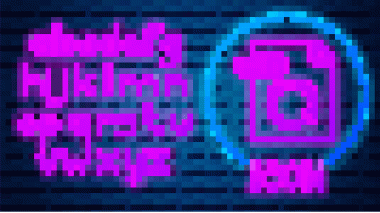Animated GIFs and dynamic HTML-5 banner creatives, limitations and advantages

How to pronounce “GIF” is fiercely debated, even though there is only one correct answer, something even Microsoft David doesn’t have right.
Jokes aside, it is one of the most common file types. The GIF format was once the only way to feature transparencies and animation on websites. Both benefits have since been replaced with modern alternatives. Transparencies can now be achieved with the PNG format, and animations through HTML-5.
And yet the GIF format hasn’t gone away. If anything, the format has increased in popularity in recent years. Those animated memes that pop up in your social feeds… they are probably animated GIFs.
An animated GIF is sort of like a video, but with severe limitations. It assembles images frame-by-frame into an animated sequence.
As teased, GIFs have severe limitations, hence why alternatives were developed to solve the previous advantages to the format. The biggest handicap of all is that GIFs can only support 256 colors. That may seem like a lot, but most screens support millions of colors. Those colors are needed to show any depth or texturing, including shadows and gradients. If the source image has more than 256 colors, it will consolidate to that limitation which is why animated GIFs sometimes have heavy pixilation.
Another potential drawback to GIFs is file size. Remember that it’s built using frames, which are each an individual image. 10 frames is the same as 10 images. Many advertising platforms impose file size limits to ensure fast loading.
Support for animated GIFs is also inconsistent. Some browsers, platforms, and apps offer only limited GIF support. Usually in those cases, it will simply show the first frame and nothing else.
You only have to look at this post’s featured image to see what can happen saving a complex images into the GIF format.
An animated GIF is best used for very simple animations consisting of only 2-3 frames and no major color variations.
Animated GIFs are popular on social channels because those platforms don’t support uploading HTML-5 files. Animated GIFs are easy to convert online, and most of the time users aren’t concerned about quality.
That’s not the case in advertising.
HTML-5 is the preferred method for animated banners. It doesn’t have extreme color limitations, and it doesn’t rely on animation frame-by-frame which means its file size is likely lower. It also offers other benefits such as improved interactivity, audio, and embedded video linking to an external source to avoid engorged creative sizes. And because it’s built using the same codebase as every website, it’s support is almost universal.
And to end the debate of all digital debates once and for all… “GIF” is pronounced with a hard G. GIF is an acronym for Graphics Interchange Format, hence the undeniable hard G sound unless you pronounce graphics as “jraffics.”




